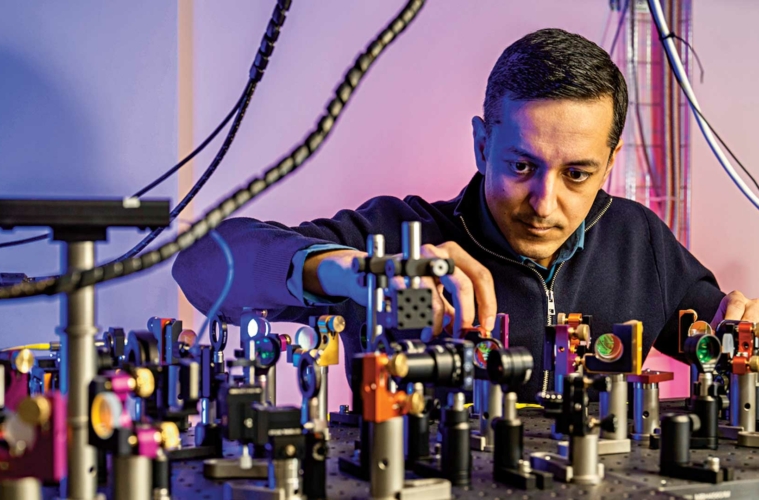Mehul Malik ’06 probes quantum conundrums, one photon at a time.
Mehul Malik ’06 has always been driven by big questions. Growing up in India, he was intrigued by the size of the universe and what might lie beyond it.
“The desire to try to answer some of the things that we still don’t understand today is what drove me to physics,” says Malik, who is now a professor of physics and Royal Academy of Engineering Chair in emerging technologies at Heriot-Watt University in Edinburgh, Scotland. “I think that journey really started at Colgate, because I realized that it’s not so much that there are these big questions we can’t answer. It’s more that our ability to experience the true nature of reality is limited by our human perception. We can’t even ask the right questions based on our five senses.”
Today, Malik uses quantum optics — the study of how fundamental particles of light called photons interact with atoms and molecules — to better understand both the universe that we can perceive and the world around us that we cannot see or entirely grasp using traditional ways of observing. For example, bits — the fundamental units of data that are the building blocks of our digital world — represent zeros and ones in classical computing. But quantum bits, or qubits, can represent zero, one, or both simultaneously.
“In my research group, the Beyond Binary Quantum Information Lab, I work with quantum states of light that can encode hundreds of levels of information, so more than just zeros and ones,” says Malik. His work has potential applications in building unhackable communication systems, powerful quantum computers that could be used to discover new materials for health care and fighting climate change, and quantum sensing techniques that could vastly improve medical diagnostics. “We do this by controlling the complex properties of light such as its structure in space, time, or even its color. We can then use these properties to study very interesting quantum effects, such as entanglement, where quantum particles can be connected over very large distances.”
For his work in quantum photonics and contributions to advancing quantum technologies, Malik has been recognized as one of the most distinguished scientists in his field by the Royal Society of Edinburgh (RSE) and Optica (formerly the Optical Society of America), both of which recently elected him as a fellow.
“Being a fellow of learned societies gives you a platform to effect change,” says Malik, who has been working with the RSE on outreach to underserved populations in science education. Recently, he started a program called STEM Seedlings, which aims to increase the number of female role models in Scotland’s primary schools. He’s also led efforts to advocate for the international mobility of scientific researchers by regularly engaging with U.K. policymakers.
This summer, he’s hosting Eli Mayes ’26, a physics major who shares Malik’s love of art. They also both received Alumni Memorial Scholar grants that allow students to travel for academic experiences.
Malik spent a summer in Paris as an undergraduate researching graffiti and Impressionism, and Mayes is using the funds to spend time in Malik’s lab. They have an art minor in common, and both have worked with Colgate sculpture professor DeWitt Godfrey. “It’s such a small world with lots of connections,” Malik says.
When he’s not busy harnessing the power of photons to make breakthroughs in quantum technologies, Malik continues to dabble in art, painting with his daughter, designing and giving scientific talks to audiences around the world, and enjoying the visual and performing art scenes in Edinburgh.
“Colgate was instrumental in helping me figure out what I really love. Not a lot of places in the world let you study physics and art at the same time,” he says. “I was able to exercise both sides of my brain in terms of creativity and analytic scientific ability, and I still do.”


